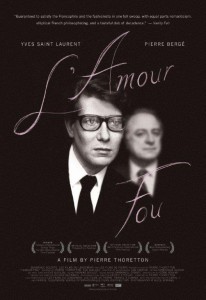
Movie Review: L’amour fou
Upon his death in 2008, famed fashion designer Yves Saint-Laurent’s partner of fifty years Pierre Bergé was left to decide the fate of the couple’s massive fine art collection. In three palatial homes in France and Marrakesh, French Impressionism mingled with the modern geometrical colors of Piet Mondrian and sculpture by the Cubist master Georges Braque. By the end of L’amour fou – Pierre Thoretton’s documentary on the influential life and legacy of Saint-Laurent – all of these treasures will be sold off one by one at astronomical costs and the stoic Bergé will be left contemplating life alone in the Paradise the two have created.

Bergé reflects on the personal comforts Saint-Laurent gained from finding new pieces to add to the collection in an extended interview he gave the day before everything was to be crated-up and shipped off to Christie’s auction house (a process given a little too much screen time to emphasize the ironic “business of art”). In Bergé, we find a stern, business-minded man obviously affected by the loss of the most important person in his life, even if they were more associates than lovers by the end. To the melancholy strains of Tchaikovsky and Shostakovich the camera floats through lavish rooms in somber reverence for the creative energy that once emanated from the private offices of an icon. “Every man needs aesthetic ghosts in order to live,” muses Saint-Laurent in the retirement press conference which opens the film. In his private museum he collected such ghosts and drew inspiration from them. The filming of each room echoes that of Aleksandr Sokurov’s one-take wonder Russian Ark (2002) in which a great swath of Russian history is retold through a long tracking shot through the Hermitage Museum.
A helpful key to fully appreciate the layers of the filmmaker’s intentions (besides a passing interest in the subject) is some awareness of the author Marcel Proust and his literary experiments with memory. Saint-Laurent was a devotee of Proust’s sentimental epic In Search of Lost Time and it is insinuated that as he grew older he was seeking the perfect “Proustian Moment” that would illuminate one’s entire life, which led to an isolated retreat from the hedonism that was a pre-requisite of his fame. What emerges at the end of the film is a melancholic figure surrounded by celebrity royalty (Warhol, Jagger, and many others are seen in home movies) who grew increasingly anxious to get back to his private chambers and the ghosts he had yet to catch.

As each of the masterpieces takes their turn at auction, Bergé solemnly observes from a private room as the money piles up. Fast-paced and financially impressive, it is an exciting conclusion for L’amour fou, but one that has returned Saint-Laurent’s lifetime collection of precious objects d’art back to mere commodities. An air of tragedy lingers.

Gregory Fichter

Latest posts by Gregory Fichter (see all)
- Bela Lugosi’s Not Really Dead: A Vampire Movie Primer - November 18, 2011
- Ten Great Summer Grindhouse Movies - August 16, 2011
- The Ten Best Johnny Depp Movies - May 19, 2011


